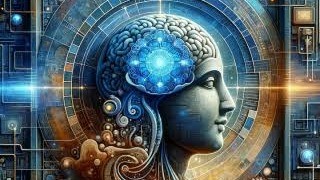Whether you study the ancient civilisations of Mesopotamia, India, or the Renaissance scholar and modern mystics, you will find that for decades, astrology has helped people make sense of their life – events and challenges – through the movement of stars and planets – making them a steady presence at the time of unclarity and turbulence. However, astrology, as we have come to know it, is now seeing a gradual shift towards Artificial Intelligence. AI-powered astrology platforms with their promise of personalisation, speed, and constant availability are transforming how people access astrological insights in an increasingly digital and fast-paced world. Through this article, we will be exploring the evolving relationship between AI innovation and traditional astrology. In addition to looking into them separately, we will see how the interpretation of ancient systems can be merged with the computational precision of AI to form a powerful alliance.
What Lies at the Core of Traditional Astrology?
Astrology has forever faced scepticism and scientific criticisms, but despite this, it remains deeply rooted in our modern culture. At the heart of human-powered astrology is a symbolic language that is built on an individual’s celestial positions – birth chart, planetary transits, and houses – that provides a framework that astrologers use to understand the recurring themes of their lives, relationship patterns, and moments of inner growth.
Every one of the astrological traditions – whether it is Western, Vedic, or Chinese – is built on its own nuances, rhythms, and cultural importance. In Vedic astrology, for example, the planetary periods (dashas) reveal decades-long events, signifying how karma has been and continues to impact an individual over time. In Western astrology, on the other hand, the outer planets’ transits are studied to mark collective change, while the inner planets shape the daily emotional life. No matter how different they are in their approach, these astrology studies have one thing in common: they are not just data; they are laced with myth, archetype, and human experience.
Another element that is common across astrological studies is that interpretation is the centre of practice. Every experienced astrologer does not just read the birth chart like a map but translates it through intuition, empathy, and cultural knowledge – a translation that could mean different things to different individuals based on personality, context, and timing. This interpretive flexibility is what allows astrology to resonate, allowing individuals to reflect possibilities and their internal landscape.
How is AI Reshaping the Practice?
AI – a field that operates on identifying patterns, processing data, and automating responses – makes it uniquely suited to manage the technical aspects of astrology seamlessly, calculating birth charts, tracking transits, comparing charts, and detecting recurring events.
On the back of these capabilities, AI is becoming increasingly popular in the astrology space with individuals using it to get daily horoscope updates, their kundli matched with others’, and detailed horoscope readings to understand how celestial bodies are impacting their specific life events.
These tools are built to eliminate barriers – finding astrologers in your area, getting their appointment, inability to get real-time readings, etc. What once took several hours of human involvement to manually interpret charts, AI can generate in seconds, making the study globally accessible. However, an important thing to note is that even though AI is built to deliver custom, rapid responses at scale, it is in no way a replacement for human astrologers. With AI reading birth charts, human astrologers can focus on interpreting them through the lens of empathy, emotions, and intuition that only a human can power.
Although AI cannot replace human capabilities, on the positive side, it will never ignore an aspect or miss a detail. Its recall ability is fail-proof – something which is both a failure and a potential. On one hand, AI with its recall ability can compare the current transit charts with thousands of others within a millisecond, but it cannot resonate with an individual’s emotional transformation and personal trauma, which is driven mainly by their tone, cultural background, and life’s context.
Another limitation lies in the fact that because the AI systems are trained on pre-existing texts, the output gets affected if the underlying content was biased or too generic. Reasons that make it risky to match the emotional, spiritual dimensions that made astrology compelling in the first place.
The Future Lies in Collaboration
The future of AI astrology, as we see it, lies in finding an answer to how astrologers can collaborate with AI to improve their practice. The great thing is that this future is not too far. Several AI astrology apps are already helping astrologers with generating charts, compiling and comparing reports, and tracking long-term transits for multiple clients. This is giving them time to focus on the human aspects – interpretation, intuition, and the therapeutic aspects – things which can never be automated.
There is also an unmatched potential for AI to support users between sessions. While astrologers attend to other people, chatbots can prompt users to journal their emotional state during planetary transits, offer reminders for key alignments, or even track personal cycles. This, in turn, creates an ecosystem built on experiences that deepens engagement and awareness.
While this is something in the present, let us now look at the future of AI astrology, one that is near distant and yet explorative.
One such potential area is real-time planetary response systems. Think of it like a smart assistant that does not just track the transits but also provides contextually aware, sensitive, emotional coaching to the app users. For example, every time your Mars return aligns with a difficult work week, the app would suggest some grounding techniques or goal-setting exercises for you – all you will need to do is make a journal entry.
Another possibility that we can foresee is cultural diversification. As natural language processing becomes culturally aware and multilingual, users could start accessing different fields of astrology – Vedic, Chinese, Indigenous, and Western fields. This could help democratise astrological knowledge globally, creating more inclusive systems. Therapeutic integration is another field where AI astrology apps can partner up with trauma-informed designs or wellness professionals, services that can be aligned with the current phase of the users’ birth charts.
These trends make one thing clear: AI will not just make astrology faster but also more cohesive.
Conclusion
Astrology has always intrinsically been about pattern recognition – mapping the celestial bodies’ movement with the unfoldings of humans’ lives, and in that sense, astrology and AI are not very different – they both find meaning in patterns, attempt to forecast, guide, and make sense of the unknown. On that note, the future of astrology will not belong to a tug of war for deciding what is better; it will see more mergers happening between the traditional and AI fields, with AI offering reach, precision, and convenience while traditional astrology will be about bringing depth, history, and emotions.
The key will lie in intentionality. AI astrology apps should ensure that mystery and gut feelings should never get mechanised and the spiritual experiences should continuously expand to give users space to reflect, feel, and grow.

